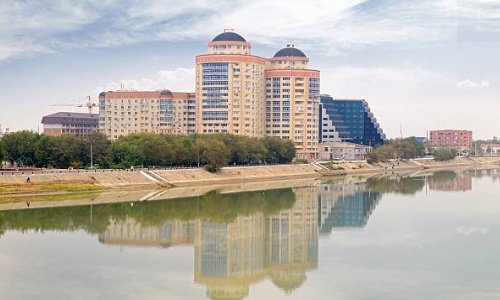
Atyrau, Kazakhstan
The Customs Union evolved into the Eurasian Economic Union in January 2015. During 2014, Kazakhstan’s economy was suffering by Russia’s slowing economy, falling oil prices, and problems at its Kashagan oil field. Kazakhstan devalued its currency. GDP in 2014 was $212 billion, growth rate is 4.3 % in 2014. The major sectors are – agriculture as 4.9 % of total economy – grain, potatoes, vegetables, melons; livestock; industry is 29.5 % – oil, coal, iron ore, manganese, chromite, lead, zinc, copper, titanium, bauxite, gold, silver, phosphates, sulfur, uranium, iron and steel; agricultural machinery, electric motors, construction materials; services take 65.6 %. Labor force is 9.1 mln.; unemployment is 5.2 % in 2012. The prevailing semi desert nature in the region, make the agrarian business very weak. National trade exports: $87.25 bln. – oil and oil products, natural gas, ferrous metals, chemicals, machinery, grain, wool, meat, coal; China 15.9%, Russia 12.1%, Germany 9.5%, France 8.5%, Italy 5.3%, Greece 5.3%, Romania 5%. Trade imports: $47.56 bln. – machinery and equipment, metal products, foodstuffs; Russia 32.2%, China 29%, Germany 5%. Debt: $157 bln. Electricity production is 90.53 bln. kWh; consumption is 80.29 bln. kWh; import 4.25 bln. kWh; export 2.93 bln. kWh; generation capacity is 17.84 GW, with 87.3 % fossil and hydro is 12.7 %. Supply and distribution of electricity sometimes is unstable because of regional dependencies. There are abundant mineral deposits in the country – approximately one-fifth of the world’s uranium reserves; gold- seventh place in the world; copper-fourth; lead, zinc-fourth; aluminum–tenth place in the world; nickel, cobalt-twelfth and seventh places in the world; iron, manganese-sixth; chromium-third in the world; coal-in top ten. Crude production is 1.63 mln. bbl/day, export is 1.36 mln. bbl/day, import is 118 000 bbl/day, reserves 30 bln. bbl. Refined production – 300 000 bbl/day, consumption – 248 000 bbl/day, export 143 000 bbl/day, import 52 000 bbl/day. Gas production is 20 bln. m3, consumption is 15.7 bln. m3, export is 11.2 bln. m3, import is 6.5 bln. m3, reserves are 2.407 trillion m3. Kashagan oil field gives high expectations to local people for prosperity. The investments, reached several billions USD, but several technical problems delayed the start of the extraction. There are large residential complexes for oil workers. There is a pipe factory investment of Chevron and other with related materials. Expectations for long lasting business with the petrol in the region, makes some big company to invest and to build local content production facilities. Around Atyrau there is several gas pump station, Chinese investment, bringing natural gas to China. The local refinery is also property of Chinese company. The airport is well maintained. The city is safe, international banks have offices. Nationalism among locals is not strong and aggressive; most of them sympathize to foreigners. English is rarely spoken. The traffic of the city is not well controlled and in pick hours the moving slows to 5-10 km/hour. The military patrols are visible in many parts of the city. Opportunities are connected to favorable relations with the biggest world power – US, Russia, China, India, Japan, and EU. All of them have big investments and interests in the local economy and Kazakhstan keeps good relations with all. Numerous big energy companies are presented there, Shell, Chevron, Total, BP, NCPOC, Lukoil, Gazprom, to name a few. Threats are mainly connected to the falling prices of oil and commodities, as those are the main contributors to the economy. The country is not affected by terrorism, or other unfavorable international situation. It keeps very strong relations with Russia, but in the same time behaves independently to important world problems. Weaknesses are as following: too much dependence on the carbon business and minerals, whose prices are unstable; in the region of Atyrau the soil is not productive, the climate is difficult and nearest big city is on several hundred kilometers, chances for diversification in near future are weak; the Caspian sea cost is not appropriate for tourism or recreation, due to the inconvenient landscape; the infrastructures in the region need big improvement, especially water supply and road traffic; local engineering capacity is weak. Opportunities are in connection of the expected start of Kashagan pumping, it will bring thousands of jobs in maintenance industry; gradually locals also get jobs in high technology businesses; the President, with national program puts target of developing hydrocarbon independent economy, through investment in infrastructure, especially in railways and tourism attractive places, transport, pharmaceuticals, telecommunications, petrochemicals and food processing; local friendly culture and safe environment will support the development, as this is the way to prosperity; improvement projects for stabilizing the electrical supply. A strategic plan of development of Kazakhstan until 2020 was adopted in 2010.






